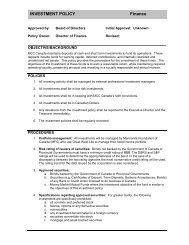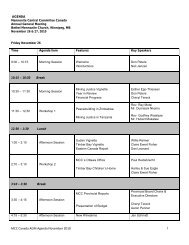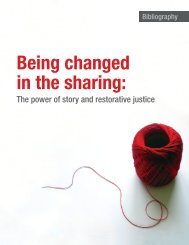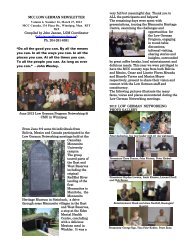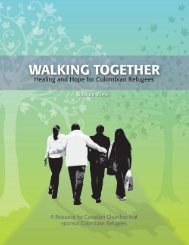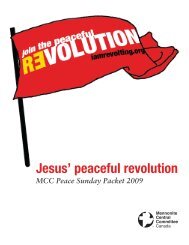to download PDF - Mennonite Central Committee Canada
to download PDF - Mennonite Central Committee Canada
to download PDF - Mennonite Central Committee Canada
Create successful ePaper yourself
Turn your PDF publications into a flip-book with our unique Google optimized e-Paper software.
Digging deeperThese reflections on resistance gobeyond the s<strong>to</strong>ries and pose uniqueperspectives or challenges. They canbe used for pas<strong>to</strong>ral reflection, assermon ideas, or Sunday school discussionstarters.Resistance and non-resistanceNon-resistance has been until recently the term ofchoice among churches of the Anabaptist tradition forwhom retaliation and going <strong>to</strong> war goes against theexpress teachings of Jesus in Matthew 5:39: “Youshall not resist evil.” . . . At the present time, mostAnabaptists committed <strong>to</strong> active peacemaking find itdifficult <strong>to</strong> think in terms other than resistance. . . .One reason for this change is positive, namely thefruitful pairing of peace with justice. Greater awarenessof the nature and roots of injustice, violence,poverty and racism as not only personal but systemichas brought about an urgent desire <strong>to</strong> address concretebrokenness and injury, and the conditions ofinjustice and violence which bring them about. . . TheChristian Peacemaker Team’s slogan is wonderfullysuggestive: “Getting in the Way.” It combines followingthe way of Jesus with getting in the way of evil, discipleship with obstruction andresistance. —Tom Yoder Neufeld, Resistance and Nonresistance: The Two Legs of aBiblical Peace Stance, The Conrad Grebel ReviewSpeaking out against warTraditionally, <strong>Mennonite</strong> commitment <strong>to</strong> peacemaking has meant a refusal <strong>to</strong> go <strong>to</strong> warand <strong>to</strong> take up the sword, but it has not involved a critique of war itself. The earlyAnabaptists unders<strong>to</strong>od the world in terms of two kingdoms: the kingdom of the worldand the kingdom of those who commit their lives <strong>to</strong> Christ.CO’s working ona dam at ClearLake, RidingMountainNational Park,Alberta. MHC,Ed Brooks Pho<strong>to</strong>CollectionThey realized that armed force, war and “taking up the sword” were part of the reality ofthe kingdom of the world. They argued that because their loyalty was <strong>to</strong> the kingdom ofChrist, they could not participate in this. They believed that their calling was <strong>to</strong> live outthe non-violent way of Christ in their communities and, in doing so being a witness <strong>to</strong> others.This is largely the kind of thinking that guided Canadian <strong>Mennonite</strong>s and Brethren inChrist churches until World War II. During World Wars I and II, <strong>Mennonite</strong>s’ concern was:would <strong>Canada</strong> provide means whereby their commitments not <strong>to</strong> go <strong>to</strong> war and <strong>to</strong> be“conscientious objec<strong>to</strong>rs” would be honoured? They did not really challenge <strong>Canada</strong>’sdecision <strong>to</strong> go <strong>to</strong> war.This has changed in the last 30 <strong>to</strong> 40 years. As a result of <strong>Mennonite</strong>s ’increasing involvementin the larger society, some <strong>Mennonite</strong>s have begun <strong>to</strong> speak out more against warand preparations for war itself. —Esther Epp-Tiessen, MCC <strong>Canada</strong>Digging Deeper26



